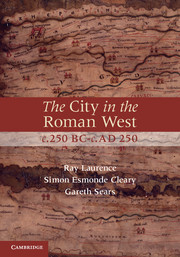Book contents
- Frontmatter
- Contents
- Illustrations
- Preface
- Introduction
- 1 The creation of an urban culture
- 2 Colonisation and the development of Roman urbanism
- 3 City foundation, government and urbanism
- 4 The reception of Roman urbanism in the West
- 5 Town planning, competition and the aesthetics of urbanism
- 6 Defining a new town: walls, streets and temples
- 7 Assembling the city 1: forum and basilica
- 8 Assembling the city 2: baths and urban life
- 9 Assembling the city 3: theatres and sacred space
- 10 Assembling the city 4: amphitheatres
- 11 The Roman city in c. AD 250: an urban legacy of empire?
- Bibliography
- Index
3 - City foundation, government and urbanism
Published online by Cambridge University Press: 05 June 2012
- Frontmatter
- Contents
- Illustrations
- Preface
- Introduction
- 1 The creation of an urban culture
- 2 Colonisation and the development of Roman urbanism
- 3 City foundation, government and urbanism
- 4 The reception of Roman urbanism in the West
- 5 Town planning, competition and the aesthetics of urbanism
- 6 Defining a new town: walls, streets and temples
- 7 Assembling the city 1: forum and basilica
- 8 Assembling the city 2: baths and urban life
- 9 Assembling the city 3: theatres and sacred space
- 10 Assembling the city 4: amphitheatres
- 11 The Roman city in c. AD 250: an urban legacy of empire?
- Bibliography
- Index
Summary
The town or city has been recognised as playing a vital role in the government of the Roman Empire. It was characteristic of the developed geography of the Roman West and was a feature that differentiated the Empire from the barbarian cultures beyond its frontiers. In this chapter we seek to outline the interplay between the city as a place of government and the city as a distinct geographical formation that was defined by means of its existence in time and space. We will begin by investigating the legal and geographical distinctions between the various types of towns, and then move on to examine the myths of town foundation that helped to define new cities and to create a sense of their past once they were established in the landscape. There follows a detailed examination of the rules of government found in the town charters: our focus will be on the charter from Urso in Spain. These charters give us a picture of the limits of government and the opportunities given to annually elected magistrates to develop their communities. The cities of the Empire were not, however, just places of politics and government. We will examine the holding of periodic markets and auctions which, quite apart from their economic functions, were a fundamental and jealously guarded legal privilege of the cities. The city also played a role as a place of justice, both locally for the community and for traders dealing with that community, and at a regional level where some cities gained status as the locations to which the provincial governor came to dispense justice. This takes the discussion of the city up to the level of the province and reveals two important roles for the city as a place from which tax was collected and from where recruits to the Roman army originated. These topics reveal the ways in which the local city was integrated into a wider vision of the Roman Empire as a territory held in common. Some cities, most notably Lyon, ancient Lugdunum, did develop as regional centres through their role as a meeting place for the worship of the deified emperors and the holding of sessions of the provincial council. We shall demonstrate that the cities of the Empire may have possessed local autonomy and a very local form of government, but could be integrated into a larger political geography at the level of the province or, more fundamentally, as part of a Roman territory that encompassed both the western and the eastern Empire.
- Type
- Chapter
- Information
- The City in the Roman West, c.250 BC–c.AD 250 , pp. 64 - 90Publisher: Cambridge University PressPrint publication year: 2011



